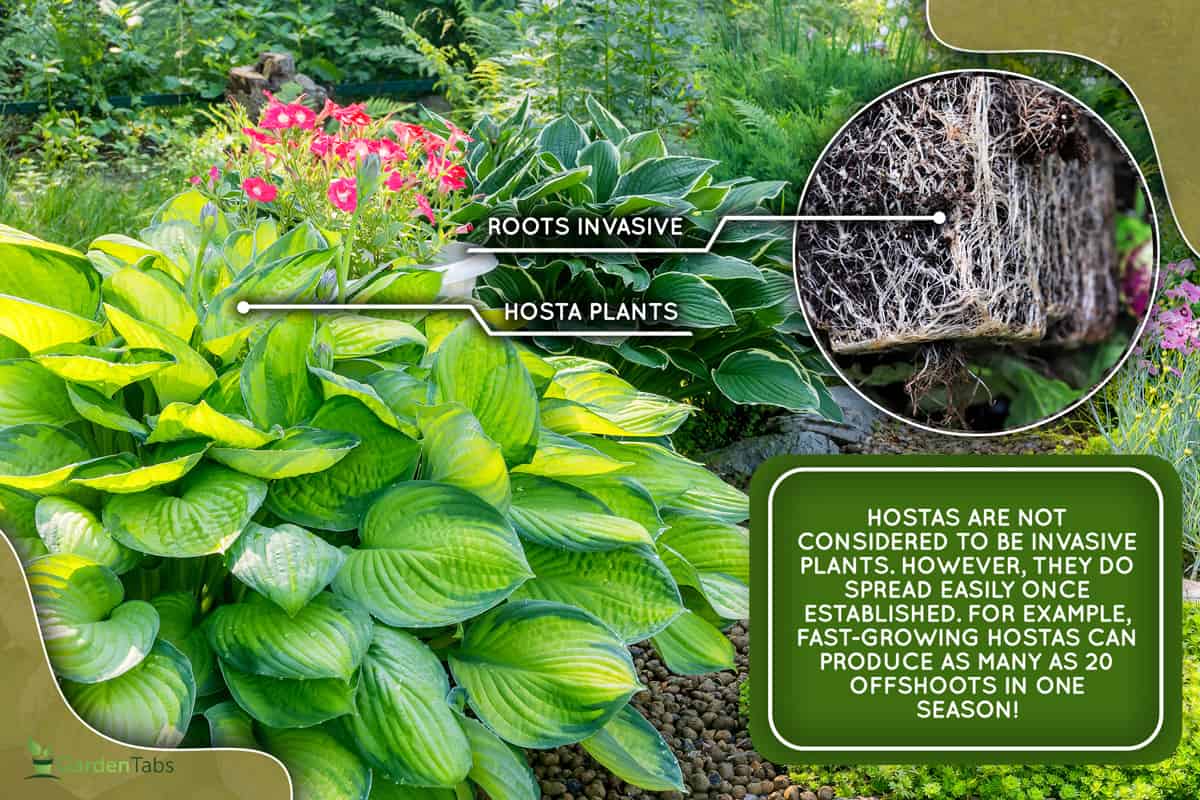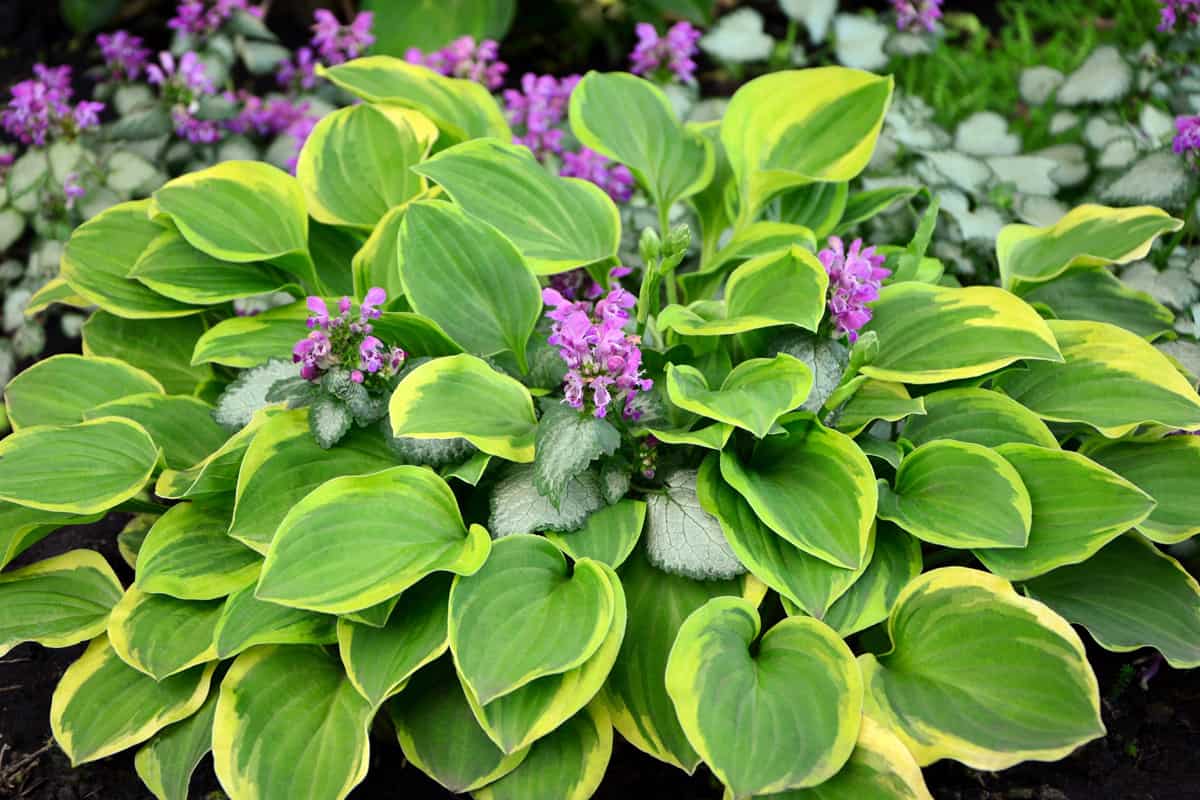Hostas are shade-loving perennials that are low maintenance and easy to care for. They are best known for their beautiful foliage, not their flowers. This makes them a popular choice amongst gardeners, even beginners. So you might be wondering—are hosta plants or roots invasive? Great question! We have thoroughly researched the answer for you.
Hostas are not considered to be invasive plants. However, they do spread easily once established. For example, fast-growing hostas can produce as many as 20 offshoots in one season!
This might lead to other questions like how do I care for hostas? Or what should I plant next to hostas? And even, how do I divide hostas? Keep reading for the answers to these questions and more!

Are Hosta Plants Or Roots Invasive?

Invasive plants are considered non-native and able to grow in many different areas, spread quickly, and grow to the point of disrupting other plants. Hostas are not invasive plants, but we do know they spread quickly and easily!
This isn't a bad thing. But proper care should be practiced to ensure the healthiest hosta without killing or disrupting other plants.
How Fast Do Hostas Spread?
It all depends on what variety of hosta you have. There are three different growing groups—slow, moderate, and fast. Hostas can take up anywhere from three to seven years to fully mature.
Once fully established, they can spread up to three times as wide as they are tall for the smaller varieties. Medium sizes spread two times their height. And the larger species are normally as wide as they are tall.
How Do I Care For Hostas?

Hostas have soil, sun, and water preferences just like any other plant. Let's discuss what hostas prefer to ensure we have a happy, thriving plant.
Soil
Fertile soil with organic matter will make your hostas flourish. Did you know that you can make your own compost from kitchen scraps? Mix in a 50/50 ratio of soil and compost.
Sun
These herbaceous plants don't have fun in the sun; they thrive in full to partial shade. The best planting area would be one that receives light sun in the morning and full shade in the afternoon. Too much sun and their leaves will crisp and turn brown.
Water
Hostas are thirsty plants and love to be well watered; moist but well-drained soil is a must. Water deeply at least one inch per week, especially in the hot summer months.
How Do I Divide Hostas?

Dividing hostas is easy! This is a great way to keep your plant healthy and also expand your garden for free! The best time to divide these plants is in the spring when the ground starts to thaw. Here are some simple steps on how to divide your hostas:
Step 1
Dig a hole around your hosta and gently pull until loose. Lift your plant out of the ground and set it down gently so as not to disturb the healthy leaves. You can use either your hands or sheers to divide the bulbs.
Step 2
Once divided, set aside the extra bulbs for planting. Replant your original hosta and water thoroughly. It is also a good idea to add some fertilizer to make sure your plant re-establishes well.
Step 3
In the spring, plant your new bulbs with plenty of fertile soil and water. Voila!
How Long Do Hostas Live?
Believe it or not, some hostas have lived for more than 30 years! Properly caring for your hosta is important in order for them to live this long. Things like fertilizing and overwintering can help them remain for years to come.
How Do I Overwinter Hostas?

Hostas will survive the winter, even extremely cold ones! They are hardy plants. Nonetheless, it is a good idea to get them ready for the winter. Here are some tips on how to overwinter your hostas:
Tip 1
Wait until the leaves have dried out before pruning. This might be after the first freeze of the season. While the leaves are still green, they are producing food for the next season. Therefore, if you cut them back too early, it could stunt their growth.
Tip 2
Use a high-quality pruning tool to cut back your hostas. The benefits far outweigh the cons. Not only will it be easier to cut back your hostas but it will also ensure the bulb is cut cleanly and correctly.
Tip 3
Surround your hostas with a layer of mulch to protect them during the winter. Mulch helps insulate the roots and protect the plant. First, prune, and second, surround the plant with mulch.
How Do You Keep Hostas From Spreading?
The best way to keep hostas contained is to cut them back, or prune them, every spring. This helps keep the plant healthy but it also helps limit how quickly they can spread. Remember to use a pruning tool when cutting them back.
Click here to see this pruning tool on Amazon.
Do Hostas Need Fertilizer?
Yes, hostas greatly benefit from regular fertilizing. Experts recommend a 10-10-10 slow-release fertilizer solution. The best time to fertilize is in the spring when most of the growth and action are happening.
Click here to see this 10-10-10 fertilizer on Amazon.
Can Hostas Be Grown Indoors?
Hostas can be grown indoors successfully with some tips and tricks. Just like with outdoor hostas, indoor hostas need ample water. Make sure the soil doesn't completely dry out. Another thing to keep in mind is the sun's requirements. Don't put them in a direct window or you might burn the leaves.
What Diseases Are Hostas Susceptible To?
Just like any normal plant, hostas too are susceptible to pests and diseases. The good news is there are some easy remedies to help ward off pests and diseases. Unfortunately, slugs and fungal diseases mostly plague our beloved hostas.
Slugs
Mostly, hostas suffer from slugs. The slugs feast on the green leaves and leave tiny holes in them. If not careful, they can completely take over and eat entire leaves which leads to killing the plant.
The best way to fix this is with an ammonia mixture. Directly spray the leaves. Pro tip—slugs are out at night, so wait until the sun sets to kill these boogers.
Fungus
Fungal diseases, like anthracnose, are wiped out with copper fungicides. The key is to catch the fungus early and apply the fungicide immediately. With some persistence, you can completely get rid of it.
Click here to see this fungicide on Amazon.
What Should I Plant Next To Hostas?
There are some great and not-so-great plants you should consider when planting next to your hostas. You want to take into consideration the sun, water, and soil requirements first. Then, think about aesthetics. How will it look? We have the top three plants we recommend to plant next to your hostas.
Bleeding Hearts

Bleeding hearts are shade-loving perennials, just like hostas. Their adorable heart-shaped, tiny flowers dangle from curved stems. They love moist, well-drained soil, making them a perfect companion for the hosta.
We think they also look lovely next to the green, bright leaves of hostas.
Perennial Geraniums

Geraniums are tough and hardy flowers that come back year after year. They do well in partial shade and moist soil. The purple, pink, and blue flowers create a mounding effect that looks stunning next to hostas.
Coral Bells

Coral bells are a perennial foliage plant best known for their bell-shaped flowers. These flowers are pollinators, attracting hummingbirds and butterflies. Their sun requirements are anywhere from shade to partial sun, making them a versatile option to plant next to your hostas.
Wrapping It Up
Hostas aren't invasive. However, they are hardy and easily spread if not paid careful attention to. Although, maybe you want your hostas to grow and take over! Either way, there are some particular ways to give your hosta some TLC and attention.
Made it to the end? Check out these related articles:
How To Stop Hostas From Spreading?
Will Hostas Grow Under Trees? [Inc. Pine, Walnut, Maple, Cedar & More]



